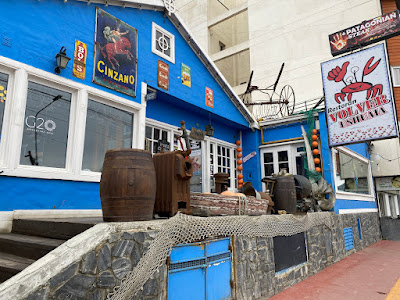Antarctica 2023
Feb 20
After finishing our Antarctic expedition, we walked from the ship back into the town of Ushuaia, Argentina. We had our luggage stored by Oceanwide until 1:45 since we weren't allowed to check in until the afternoon. We still walked up the hill to the Patagonia Jarke Hosteria and dropped our backpacks at our hotel, then sat in the lobby and connected to their WiFi. I had 442 emails after being disconnected for 18 days, most of it was junk mail.






The stairs coming down to the street from our hotel were very sketchy, boards are warped and cracked, loose or missing, but we made it down alive, and went for a town wander.
















We were looking for unique (easy to pack) gifts to take home with us, and bought out the Moala chocolate cafe of all their chocolate penguins, they had to make some fresh ones for us. I think the recipients were pretty happy with their Dulce de Leche Pinguinos.



Having killed as much time as we could muster, we headed to the same luggage drop-off location and picked up our suitcases. We ran into most of our ship friends there, and said our final goodbyes as they were heading off to the airport. From there we easily caught a taxi and checked in to our hotel.


It was a far cry from our last Ushuaia lodgings, the lobby and lounge areas were nice, but the room was dated, a small window opens to a view of the lobby. The dripping heat register in the room is cranked, so the temperature must be over 30° (90+ Fahrenheit), and the tap in the bathroom is constantly dripping. At least the lounge had a nice view of the harbour, and breakfast was included.




We have a good view as our ship, the Hondius, departs for it's next expedition to Antarctica.





We met the Aussie ladies for dinner at Komenk, we first tried a nearby pizza place but it
only fit 4 people at a counter.
With Norine's Spanish put hard to work, we had good food and some good laughs before
heading back to our hotel.
Feb 21
Today we were picked up early for a Tierra del Fuego National Park tour in a small bus.





Our first stop is at the Beagle Channel and the Post office at the end of the world.



















There is several Southern Crested Caracaras wandering around the park area near our bus, several juvenilles and an adult. These are cousins of the ones we saw in The Falkland Islands, but a little more colourful.










Our nest stop was a trail system in a forest area that has been destroyed by beavers. Apparently in 1946 settlers in the area had the bright idea to bring twenty pairs of Beavers from Canada to start a fur trade. The demand wasn't there and the trade didn’t go well, so the beavers were released and expanded into over 150,000 beavers in both Argentina and Southern Chile because they have no local predators like wolves and bears. The beavers chew down trees, build lots of dams, and create flooding problems around the regions they occupy. The governments of Chile and Argentina are now attempting to eradicate the North American beaver.










Don't pay any attention to what that horse on the far right is doing
Our next stop was Bahia Lapataia (Lapataia Bay), it is the most southern point of the longest highway on the planet. Here you’ll find a wooden sign marking the end of National Route 3, the last leg of the Pan-American Highway network. This is the farthest south you can drive in the Western Hemisphere.


Near the sign is a boardwalk leading out to the bay, a remote fjord at the tip of Argentine Patagonia. The fjord is a branch of the Beagle Channel, which was named after the boat carrying Charles Darwin on his journey.


This secluded wilderness has been inhabited for 10,000 years, recently only by the indigenous Yámana people, who gave the bay its name, which means “Bay of Forests” in the native Yámana language. They were known to build fires as a form of communication between islands, which inspired the name Tierra del Fuego, or 'Land of Fire'. The Yámana people were traditionally nomads and hunter-gatherers who traveled by canoe between islands to collect food.
The sad story in this region is much like the indigenous stories in Canada, Australia and other countries... Europeans arrival to the area and introduction to their people brought illnesses combined with a religious attempt to make them 'civilized', and it ended up wiping them out. In 1833, the Yámana numbered 3000, come the turn of the century there were fewer than 200. After inhabiting Tierra Del Fuego for more than 10,000 years the Yámana are now extinct.






Our next stop was Lago Roca, a very large lake that is 70% Chilean and 30% Argentinean.












Our last stop was the Southern Fuegian Railway's el Tren del Fin del Mundo (Train to the End of the World). Its predecessor, the prisoners' train, began operating in 1909 until 1952, but then the company Tranex Turismo decided to revive the legend by creating the famous End of the World Train, which runs the last 8 kilometers of the original route (formerly it was 25 km).




Of course we ran into the Aussie ladies on the train.







The train connected the prison in Ushuaia with the forest and passed along the coast in front of the growing town. It was known as the Train of the Prisoners, and carried as much wood for heating and cooking as for construction. The railway was gradually extended further into the forest, in remote areas as the wood was depleted. Open fields of stumps still remain from where the logging was done by the prisoners. In 1947 the prison was closed and replaced with a naval base. Two years later the 1949 Tierra del Fuego earthquake blocked and destroyed much of the line, the service became unfeasible and it was closed in 1952.


















Wild horses lounging in the park

With our train ride complete, we were dropped back in Ushuaia and had a good lunch with questionable service at Isabel Cocina al Disco.They didn't even have dancing, how do they call it a disco?



Since we had the rest of the afternoon free, we checked out the Maritime and Prison museum.






The Ushuaia prison operated in Ushuaia between 1902 and 1947. The harshness of the weather conditions and the geographical isolation of the southernmost city in the world reinforced the security of the prison, intended for highly dangerous criminals, and sometimes also used for political detainees. It was compared to Alcatraz, Devils Island and Old Melbourne Gaol as one of the most notorious prisons. Prisoners were treated severely, and the best behaved worked the logging trade in Tierra del Fugeo taking the train each day. The majority of construction building up the town of Ushuaia was performed by the prisoners. After it closed in 1947 based on humanitarian reasons, it was transferred to the Argentine Navy.


Today it is a museum, some elements left to show what it was like, and others are cells containing a mix of local artwork and displays on other prison systems, the indigenous people of Argentina, and Antarctica history.



Apparently there was a paint your penguin competition.



















Some of my favourite art pieces
From the museums at the far end of town we walked back to the hotel, avoiding the crowds, noise and spray snow of the Carnaval celebrations that were going on closer to the waterfront.



When we get back to the room, the radiator has been cranked back to max. The room is sweltering and the radiator and tap are dripping. We crank open the room and bathroom windows to cool it down, and I use the water shut-off taps under the sink to try and stop the dripping. We only have to sleep here this last night.
Just as we are about to go to bed, I start getting mystery charges on my Credit Card blowing up my phone, somewhere we stopped today (Gift Shop, Restaurant or Museum) has skimmed my CC info and is trying to do their shopping at Zara's and lightinthebox.com. I tried to deal with it using the WiFi until it finally just says "Call this number"... so I turned off airplane mode and ended up on hold with Capital One. That's OK, it says it is a Collect # for international travellers, after 2 hours of listening to their lousy music and sales pitches they hung up with out ever answering.
I called back, they finally answered and my card has now been cancelled with a new one being sent to my home… that’s helpful while traveling. When I got home, my new card had arrived, along with a $15 roaming fee and $67.51 in long distance charges.
Time to continue our travels North with one less Credit Card.


